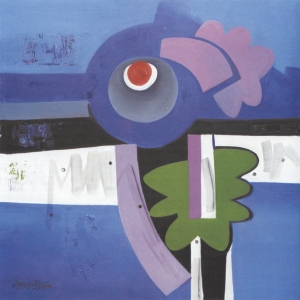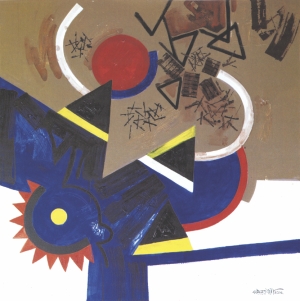| Home - Back Issues - The Team - Contact Us |
 |
| Volume 11 |Issue 11| March 16, 2012 | |
|
|
Art The Naturalist Qayyum Chowhdury's 80th birthday brings 80 depictions of nature Fayza Haq
At a press conference at the Bengal Gallery, with 80 colourful paintings, on Bengal's village and women, Qayyum Chowdhry gets ready to celebrate his 80th birthday. Like Paul Klee, Qayyum says, he is all about colour. Known all over the Subcontinent and beyond, from the US to the East, as Rafiqun Nabi puts it, he is a painter loved by both children and adults. His contribution to graphics can never be forgotten. Whether it be greeting cards or posters, or illustration of books and book covers, Qayyum’s signature style is well known. He tirelessly filled his notebooks with illustrations, sketches and poem. He illustrates for Prothom Alo and Kali o Kalom. Does the artist at 80 feel he has done all he had ever wanted to do? He says it is part of his happy and contented existence. Rafiqun Nabi, Abul Mansur, and his gathered colleagues and peers, have said that like Pablo Picasso one can recognise his work anywhere. They have also likened him with Jibananda Das in his preoccupation with the countryside of Bengal. The artists, who have gathered on this happy occasion, insist that he presents the soul of Bengal. They say that he feels the rhythm of the working people in his depiction of the bursting sun, flowers, trees, bushes, cockerel, chirping birds, flower and nagordola. They also mention how he depicted the struggle and freedom of the people of Bangladesh, in the Language Movement and the Freedom Movement of 1971. His zeal to drive out the marauders is seen in his posters, illustrations and paintings of red and green—the colours of freedom.
“Nature, people and the country,” says Qayyum, “is what I wish to present. They have inspired me to paint my surroundings. How to capture all these elements and to make them appear modern is what my teachers and instructors have taught me. It is not just in Bangladesh that I learnt my art but also in the outside world especially in Japan and the States. I was taught to depict the heritage of mankind, of which I am a part. I was also taught to show something new in my paintings. I went overseas to study the different museums and galleries. I exhibited in the Bangladesh High Commission in the US.” Qayyum says that each country has its culture to learn from. Each country has its own contribution to painting. He adds that when a new country gave him something (in terms of artistic growth) he took it that willingly. "The world outside has shown us the path of how I could best depict my culture and heritage," the painter cum illustrator says.
Asked to talk about how he entered the realm of art, Qayyum says that painting is as important as other professions like engineering and medicine, or even law. It is from our background that we wish to contribute to our society, he says. The manner in which a poet, writer or painter contributes to society is understood only when one studies the creative person's work, the icon among painters says.
Talking about whether he prefers painting to illustrating, Qayyum says that he enjoys both, as he contributes to mankind through both fields. Like most painters of his generation, the Liberation War has had a significant effect on his work. Qayyum says, "Sometimes there was an element in my work. Just before the Liberation War, there was not the bright colours one finds before or after. There was a time for experimentation in my paintings. I tried to break the normal form and present new ones. I went back to my life with folk motifs and folk art. Today too there are motifs taken especially from the kantha or embroidered quilt, the design of the pitha (rice cakes), or the hari that contained colours and designs based on gods and goddesses and innumerable animals and snakes taken from myths and stories painted on mats. I presented the motifs in my own way, a modern manner that would appeal to all. They worked on three-dimensional objects while I paint on canvas.”
Asked to elaborate on the crafts and roots of his people, who have inspired him, he says that it is Nature that has basically inspired him. He says that he has taken the crafts from nature and the people dealing with them. He says that he has tried to bring in the cultural behaviour of the simple, village people. Folk literature, dance and music definitely influenced him. Expanding on how Rabindranath Tagore influenced his paintings, Qayyum says, “Seeing my recent paintings, you will find that I've changed a lot. I've tried to express myself in a broader, newer way. In the beginning, my work was influenced by academic ways, which formed my education. Later on, my experience, my exchange of ideas with others and various interactions influenced my work. I tried to maintain my personality all along. Every time, I tried to make my work as modern as possible.” “The vibrancy from our victory in the Liberation War entered my paintings, as I also tried to show the change in the life of the common people,” says the silver-haired painter who has won many awards both at home and overseas, including the coveted “Ekushey Padak”. Note: The exhibition 'The Quest for Self' at the Bengal Gallery of Fine Arts ends on March 22. |
||||||||||||
Copyright
(R) thedailystar.net 2012 |




